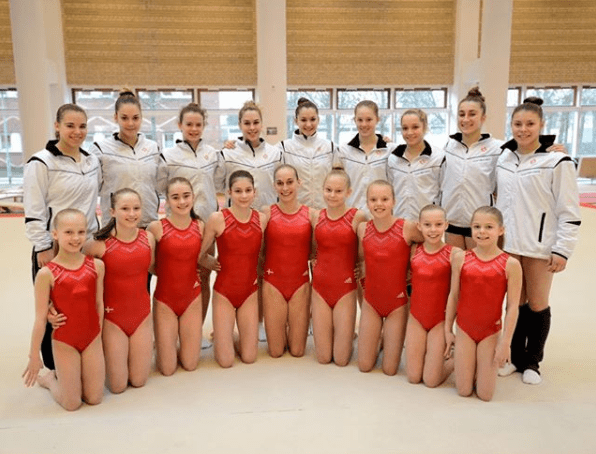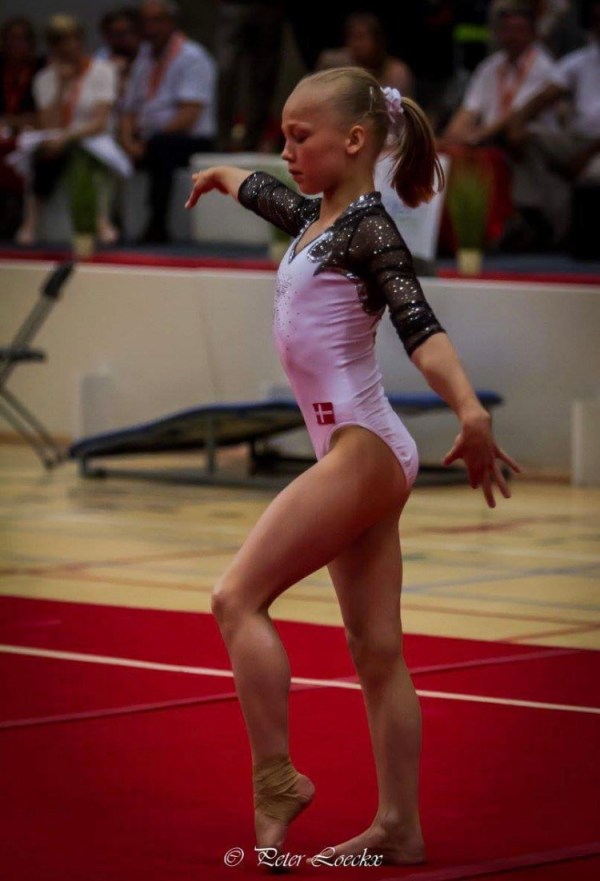
Denmark isn’t a country you’d typically think of as a powerhouse for gymnastics. The country’s sole Olympic appearance was 50 years ago and no gymnast has made a final at world championships, with Mette Hulgaard‘s 53rd-place finish in 2013 the best to date.
This is where Camille Lund Rasmussen comes in. 13-year-old Camille, who trains with Hulgaard at KG66 in Copenhagen, burst onto the scene last year, her first year officially at the espoir level, winning the gold medal at Danish Championships before going on to get international prizes, including all-around bronze at the Gymnova Cup in Belgium and the gold at the Turnkunst International competition in Hamburg.
Camille won multiple medals in every competition she entered this year, once again becoming the Danish national all-around champion — this time in the junior division — while also getting the Gymnova Cup gold, silver all-around (as well as three event medals) at Nordic Junior Championships, and bronze all-around in a combined junior and senior field at the Austrian Team Open.
But nothing shows her potential like her competition at Northern European Championships this October. At 13, Camille placed fifth, just tenths away from the all-around podium, behind four experienced senior competitors who were all members of their nations’ worlds teams in Montreal a few weeks prior. In addition to her excellent all-around performance, Rasmussen won the silver medal on vault and became the floor champion, once again in a heavy senior field.
Camille’s gold medal performance on floor at Northern European Championships
Camille is already killing it in international competition, and she still has a full two years before she needs to be competitive at the senior level. The Tokyo qualification process for her — she won’t be able to compete as a senior until 2020 and therefore won’t have the opportunity to earn an Olympic spot at worlds the year prior, a major flaw in this new qualification system — isn’t going to be easy, but if anyone can make it happen, it’s Camille.
We talked to Camille about her career and what we can expect from her in 2018 as she officially becomes eligible to compete at the junior international elite level. Enjoy!
When did you start gymnastics?
I started doing gymnastics when I was five years old. I was lucky because I live in Copenhagen near my current club, KG66. I started doing gymnastics for fun but somebody spotted me as a talent and I moved to a more serious team.
What about gymnastics made you fall in love with the sport?
It was kind of a coincidence that I started at gymnastics but soon I realized that it was where I belonged.
I think I like the seriousness and the focus on details and probably also because I quickly realized that I am good at doing this.
When did you realize you had a lot of talent and could reach the highest levels?
I probably realized I had some kind of talent when I went to my first international competition, the Mälarcup in Sweden in 2012, where I was lucky to get a bronze medal on vault.
How did your coaches and older teammates help you prepare when you first started competing at your first national and international meets?
Fortunately my coaches Bernadett Balazs (Ditti) and Milan Udvaracz have great international experience and they gave me good advice. My older teammates, especially Mette Hulgaard and Marie Skammelsen, also helped me a lot. They calmed me if I was nervous.

Camille, front in blue and white, with her teammates — including Marie and Mette — at the Mälarcup in 2014
How did it feel the first time you got to compete internationally? Do you have a favorite memory from this meet?
My second international competition as a youth, when I was nine years old, was in Hungary in 2013. I was so lucky and happy to be in the same subdivision as two nice and really good Russian girls, Ksenia Klimenko and Arina Strukova. It was a great experience and very inspiring, because I knew that Russian girls are fantastic gymnasts. We had a great time and even though we don’t speak the same language, we had some kind of connection. I have a nice picture of the three of us together.
Another good memory is from a competition in Hamburg in 2016 where I joined an international friendship team together with Belgian girls (Lisa Vaelen and Cato Fleurackers) whom I knew from former meets, like the Gymnova Cup in Belgium. It was a lot of fun and we did really well as a team.
Next year you’ll get to move from the youth to the junior elite level. What are you most excited about to get to this next level, and how has your preparation been going?
I am so much looking forward to the junior level. My next international competition is probably the junior Nordic Championships here in Copenhagen and after this the European Championships in Glasgow. I am excited about all the fabulous girls from all over Europe that I hope to meet and compete against.
I have some new skills I am working on. It is hard but the preparation is going well.
What are the new skills you’re looking forward to competing in the future? If you could do any skill, what would it be?
I am working on several new skills. A Yurchenko double on vault, a giant with a full turn on bars, and sometimes I work on double layouts with some help on floor.
I really would like to do a double back with a full twist on floor and a Shaposhnikova on bars.
What are your favorite skills to compete now?
My favorite skill probably is my Yurchenko full. I got a silver medal in the Northern European Championship this year with this vault. I hope soon I will be able to do the DTY.
Do you have any fun stories from training or competitions?
It is a great memory from last year when the national team from Switzerland had their training camp at our gym. It was really fun and exciting to be in the gym with Giulia Steingruber and the other girls from Switzerland.
The training with all my teammates every day is great. They are among my best friends. We understand each other and talk and laugh together.

Training with the Swiss national team at KG66
What does a regular day look like for you? Do you find it easy to balance the gym, school, and everything else?
I have seven training sessions a week. Monday I train in the morning and evening but Tuesday to Saturday it is only in the evening. I train about 21 hours a week.
I go to school every day from 8 AM to 3 PM.
I try to do my homework right after school because I am too tired after training.
Sometimes I meet with my friends after training Saturday and on Sundays. It is a tight plan all week and until now it seems to work but sometimes I am really tired.
My friends outside the gym are really good at having my training schedule in mind so we can find time to see each other.
Outside of gymnastics, what are your favorite things to do?
I love to be together with friends and family and just relax. I also like to play with my two little sisters.
When it is possible I go with my family on vacation abroad. I like warm places with lots of sun. In winter time we go skiing; that’s really fun.
Do you have a favorite competition that you’ve been to so far, and why was it your favorite?
I have many really good competition memories but I think my favorite must be the Northern European Competition because I competed with all the seniors. I have only competed once in this but it was great fun.
Who do you look up to the most in the sport?
I really like Laurie Hernandez because she is so young and so good at gymnastics, and she is just herself.
What are your goals or dreams in gymnastics?
My nearest goals are medals in the Nordic Junior Championships and I really dream about winning a medal at the European Championships. But my biggest dream is going to the Olympics.

We can’t wait to see what Camille can do in the future and look forward to cheering her on at Euros next summer!
Article by Lauren Hopkins



Our country India need thinkers like yours who can make change in the gymnastics. Thanks for the post.
LikeLiked by 1 person
She is so sweet and had really thoughtful answers! Looking forward to following her journey.
LikeLiked by 1 person
I love her! She’s fabulous and I really want her to make it big. 🙂
LikeLike
Hmmmm for 2020 quals, I could see an interesting compromise be like the top 5 or maybe a few more junior age eligible for qualifying as one of the individual slots for their country at Junior Worlds. Especially since if there is an actual team format (ie all the countries actually participate aka US) the AA field will be dominated by countries who will have most likely qualified full teams, ie Russia, USA, China, GB, Japan, Canada etc. Which would give athletes from small countries a shot! Could be interesting, especially since we know they will probs change this process again before 2019.
LikeLike
I have to stop getting myself excited.. I rooted so hard for Marie Skammelsen.. 😦
LikeLiked by 1 person
Pingback: Around the Gymternet: Chocolate, chocolate, chocolate, ack! | The Gymternet